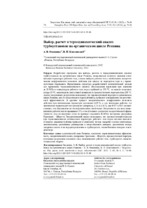| dc.contributor.author | Овсянник, А. В. | |
| dc.contributor.author | Ключинский, В. П. | |
| dc.coverage.spatial | Минск | ru |
| dc.date.accessioned | 2022-02-23T13:02:50Z | |
| dc.date.available | 2022-02-23T13:02:50Z | |
| dc.date.issued | 2022 | |
| dc.identifier.citation | Овсянник, А. В. Выбор, расчет и термодинамический анализ турбоустановок на органическом цикле Ренкина = Selection, Calculation and Thermodynamic Analysis of Turbine Units Based on the Organic Rankine Cycle / А. В. Овсянник, В. П. Ключинский // Известия высших учебных заведений и энергетических объединений СНГ. Энергетика. – 2022. – № 1. – С. 76-88. | ru |
| dc.identifier.uri | https://rep.bntu.by/handle/data/109831 | |
| dc.description.abstract | Разработана программа для выбора, расчета и термодинамического анализа турбоустановок на органическом цикле Ренкина, позволяющая получить значения оптимальных параметров рабочего тела, а также выбрать рабочее тело с наибольшим эксергетическим коэффициентом полезного действия для циклов на перегретом паре и с промежуточным перегревом. Представлена структура разработанной математической модели для проведения термодинамического анализа. Исследования проводили при давлении до 20 МПа и температурах рабочего тела: перед турбиной до 250 °С, на выходе из конденсатора 25 °С, максимально допустимой на выходе из промежуточного перегревателя 250 °С. Анализ полученных результатов показывает, что промежуточный перегрев в органическом цикле Ренкина, как и в классическом паротурбинном, приводит к повышению эксергетической эффективности. В среднем прирост эксергетического коэффициента полезного действия при оптимальных параметрах составляет 4,28 %, а для некоторых рабочих тел значительно превосходит этот результат (например, 8,14 и 6,56 % для R717 и R32 соответственно), что обусловлено их теплофизическими свойствами. Погрешность для всех низко-кипящих рабочих тел не превышает 2 % от полученного результата эксергетической эффективности. Для исследуемых схем на примере хладагента R245FA построены диаграммы Грассмана – Шаргута. Эксергетический анализ показывает, что промежуточный перегрев при термодинамически оптимальных параметрах рабочего тела перед частями высокого и низкого давления турбины приводит к снижению потерь эксергии в котле-утилизаторе, значительному увеличению регенерации в теплообменном аппарате, увеличению потерь эксергии в насосе и их перераспределению в турбоагрегате, теплообменном аппарате и конденсаторе. | ru |
| dc.language.iso | ru | ru |
| dc.publisher | БНТУ | ru |
| dc.title | Выбор, расчет и термодинамический анализ турбоустановок на органическом цикле Ренкина | ru |
| dc.title.alternative | Selection, Calculation and Thermodynamic Analysis of Turbine Units Based on the Organic Rankine Cycle | ru |
| dc.type | Article | ru |
| dc.identifier.doi | 10.21122/1029-7448-2022-65-1-76-88 | |
| local.description.annotation | A program has been developed for the selection, calculation and thermodynamic analysis of turbine units based on the organic Rankine cycle, which makes it possible to determine the values of the optimal parameters of the working fluid, as well as to select the working fluid with the highest exergetic efficiency for cycles on superheated steam and with intermediate overheating. The structure of the developed mathematical model for thermodynamic analysis is presented. The studies were conducted at pressures up to 20 MPa and temperatures of the working fluid in front of the turbine up to 250 °C; the temperature of the working fluid at the outlet of the condenser was 25 °C, while the maximum temperature of the working fluid at the outlet of the intermediate superheater was 250 °C. The analysis of the results showed that the use of reheating in the organic Rankine cycle – as well as in the classical (i. e. steam turbine) one – led to higher exergic efficiency of the cycle. On average, for the studied working media, the increase in exergetic efficiency at optimal parameters of the working body was 4.28 %. However, some working media significantly exceeded this result (for example, 8.14 and 6.56 % for R717 and R32, respectively) due to their thermophysical properties. The error for all low-boiling working media did not exceed 2 % of the obtained result of exergetic efficiency. Grassmann – Shargut charts were made for the studied circuits using the example of the refrigerant R245FA. Exergetic analysis demonstrated that intermediate overheating at thermodynamically optimal parameters of the working media before the high and low pressure parts of the turbine causes a decrease in exergy losses in the heat recovery boiler, a significant increase in regeneration in the heat exchanger, an increase in exergy losses in the pump and their redistribution in the turbine unit, heat exchanger and condenser. | ru |

